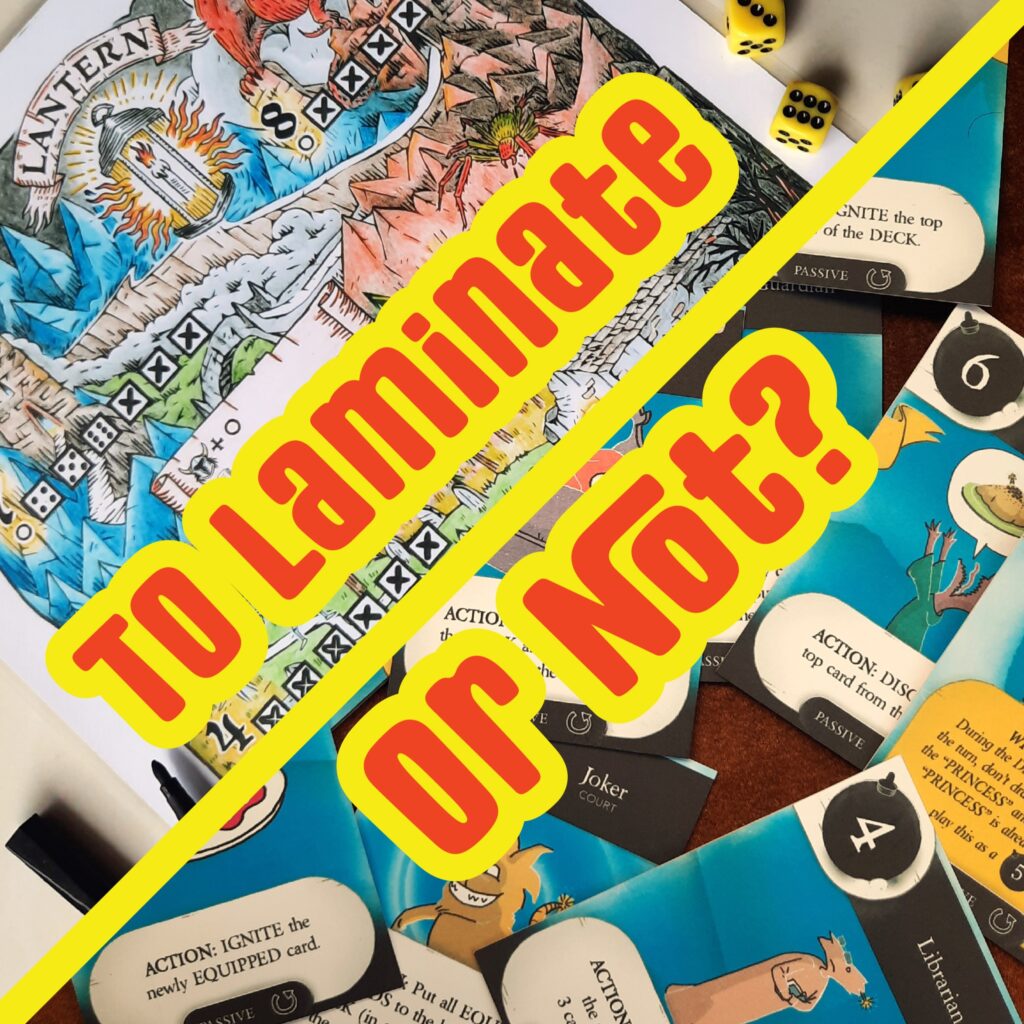When to (and not to) Laminate game parts

Not all that shines is gold, but can be very precious!
As we unearthed our prized print-and-play game of Lantern from the shelf and introduced it to our friend circle, it was met with both awe and frown- the former more than the latter! While most were enchanted with Lantern’s amazing game design and shiny, finished look, the rest frowned on the printed game being too ‘glossy’- aka, laminated! Lamination certainly brought a big environmental angle into the discussion, but sustainability is also compromised when the unlaminated games do not last long and need to be printed over and over again. Hence started an intense yet very fruitful discussion as to when and why the print-and-play games need lamination. And we thought of sharing the summary of that fruitful discussion with you!
Here’s when you should, and should not, laminate print-and-play games.
Short run versus Long run
The first factor is as straightforward as possible. Ask yourself, am I planning to shelve this game for a long time? Or am I going to try it once to give it a shot? If you are going through the ‘Litmus Test’ Phase of the game, where you are still unsure if you will like it, then it’s wise to not laminate it immediately. Laminate the PnP games only when you are certain that you want to shelve this game for a long time, which will not only be sustainable but also not compromise the game experience.
If you have enough experience playing PnP games, then the Litmus Test Phase for any game can also be conducted by watching gameplay videos or game review blogs to decide if it is your type. That’s what we do!
The type of game
Say you have decided to shelve the game for the long run. The next factor you have to address is the type of game we have in the equation. For example, we happily laminated the game Lantern because it is a roll-and-write game. It is a type of game that requires us to write or mark actions on the game print. Instead of using a pencil and rubber, we opted to print and laminate the game and went on to use a sign pen or marker on it. That way, the game print can always be wiped clean with a tissue or wet cloth, to have it fresh for the next round. So, when it comes to roll-and-write games, lamination is a go!
On the flip side, if the game is solely based on a deck of cards, then we recommend not to laminate the cards. We have played and reviewed games like All is Bomb and Galdor’s Grip, which are entirely based on a deck of cards that has prints on both sides. For both games we ended up trying three different modules:
– Both sides of the cards are printed on A4 paper, glued together, and then laminated
– Both sides of the cards are printed on cardstock paper, and then glued together
– Both sides of the cards are printed on cardstock paper, cut out, and then assembled inside card sleeves.
The first module was complicated and backfired big time. Not only was it difficult to assemble, but the finished product was not as pleasing. A big red flag on laminating thick paper! As for the second module, we liked it best since it added to the aesthetic appeal, but the cards may not serve in the long run. However, for the third module of using card sleeves, not only was it easy to cut and assemble, but it also had a nice finished look to the cards. Laminating can make a deck of cards too sturdy, which is not recommended.
So, in case of a deck of cards for a game, do not laminate. Opt for card sleeves, which are quite affordable!

Type of Paper
As you can already tell from our previous point, we learned the hard way that the thickness and type of paper play a big role in deciding whether to go for lamination or not. We laminated offset paper ranging from 80 gsm to 100 gsm, and they turned out to be great. But upon trying to laminate cardstock papers, or any paper thicker than 180gsm, we noticed that the lamination occasionally opens up, which can be disastrous. Lamination can be hard to glue back, so it’s best to not opt for lamination when it comes to thicker papers or cards.
Frequency of play
Be it short or long run, the frequency of play is one of the detrimental factors for laminating games. Do you play the game frequently? Is it popular in your newly formed game club? Is the game passed on to others for game nights? If the answer to all those questions is a big-fat yes, then it’s best to prepare the game for the high frequency of gameplay. PnP games that are printed on traditional offset papers are guaranteed to wear and tear upon regular gameplays. So upgrade the paper either by lamination, or any other methods you see fit.
Player age and lifestyle
Are kids involved in playing print-and-play games? Or rather, are there players who behave like kids? Is it common for you to snack while playing? Do you like to play PnP games while you are traveling? If any of the answers are a Yes, then you know what to do! That is if lamination is the solution to the type of game we are dealing with, as mentioned in the second point.
Aesthetic Appeal
You do not play print-and-play games and not develop a knack for aesthetics! Thanks to the amazing game arts that we encountered while playing PnP games, we believe how the game feels in our hands is as important as the gameplay itself. That is the entire reason we are playing games tangibly instead of playing them online! When it comes to aesthetic appeal, a lot depends on your personal preference. For example, we loved to have our prints for All is Bomb in cardstock papers, and chose to not laminate them. We loved how the card felt to touch, and had a unique experience playing with a non-glossy deck for the first time in our lives!
When playing Galdor’s Grip, which requires frequent card movement compared to All is Bomb, we found that the game experience got compromised due to the friction caused by non-laminated cardstock during shuffling. So we opted for card sleeves for the game, which resolved the issue. Notice how we approached two different solutions for games that are similar in nature? Always lean on your preference, and let aesthetic appeal be on that list!

Cost
Oh, the one factor to rule them all! We saved the best for the last.
At the end of the day, you have to do a quick math to determine if laminating the games is worth it. If you do not have a laminator or printer, do the math right away:
-How much am I spending to print on PnP games?
-How much is my travel expense every time I go to a store?
-How frequently do I print the game that I like? (multiply it with how much you’re spending on printing)
-How much is the cost of laminating at stores near to me?
-How frequently am I laminating PnP games?
-How many PnP games am I trying every month?
-How many PnP games am I planning to shelve?
Once you have listed your monthly expenses, calculate how much you spend in a year.
If you are lazy enough to do the math then allow us to make your life easy by stating the inevitable- having a laminator and a printer is much, much more economical than having to print and laminate games from stores. So if you are in PnP games for the long haul, just go for it! It is much cheaper than you think it is.
We are not sponsored or up for promotional grabs, but we can share the printer and laminator that we are using on our PnP journey, and loving it so far!
Laminator: 9-Inch Thermal Laminator
Laminating Sheets: Clear Thermal Laminating Sheets
Printer: Canon PIXMA G6020
We hope you found the summary of our fruitful discussion helpful!

Tasliman is a board game developer based in Bangladesh, with the dream of exploring the world of games and introducing it to anyone new to it. He is the founder of Kraftz, a brand that develops board games commercially, as well as with reputed entities like BRAC and The Gates Foundation.




